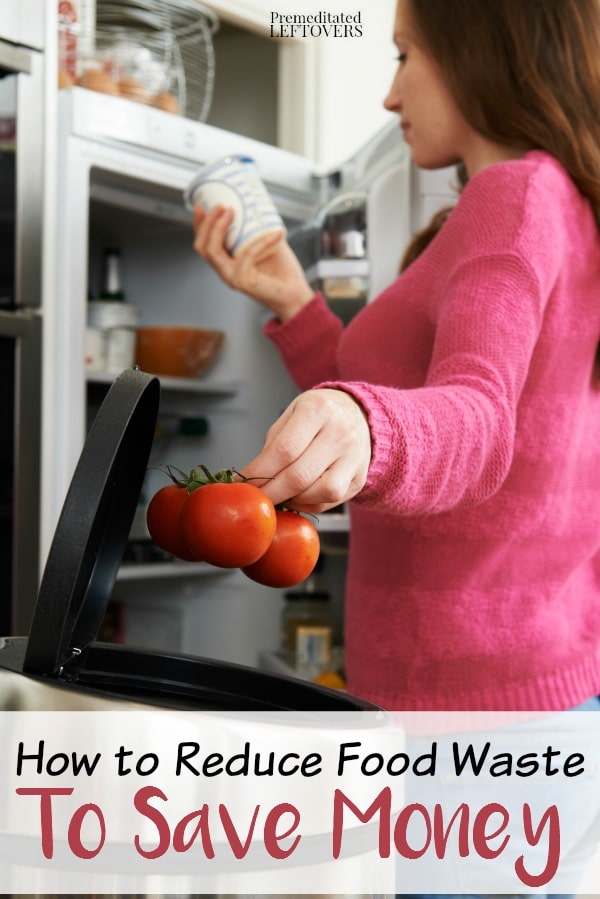Would you like to stretch your grocery budget further? Use these easy tips on how to reduce food waste and save money on groceries.

Have you resolved to save money? Reducing food waste can help with your goal. Before you can eliminate food waste, you first need to figure out why you are wasting food. Analyze what you are throwing away to see if there is a way to eliminate that waste.
How to Reduce Food Waste
To reduce food waste, you first need to analyze the problem to identify where you are wasting food and why.
- Are you throwing away leftovers that went bad?
- Are you throwing away stale chips, crackers, and cereals?
- Are you throwing away expired food?
- Are you throwing away rotten vegetables and fruits?
How to Stop Wasting Leftovers
If you are tossing out leftovers, there are a couple of things you can do to reduce waste:
Make less food! Seriously, you can easily halve a recipe instead of making more than you need.
Freeze your leftovers. Frozen leftovers make great “t.v. dinners” for busy nights. Just pull them out and reheat them in the microwave and you have an instant dinner. This is healthier and more frugal than picking up fast food on hectic nights.
Make a resolution to eat your leftovers for lunch. When putting away leftovers, divide them up into single servings and package them in containers that fit in your lunch bag. Reheat them at work and you will save tons off eating out at lunch.
Find new ways to repurpose your leftovers. This is my favorite. I love finding new ways to use up leftovers in an “encore meal”. For example, use leftover taco meat in a taco salad, use leftover spaghetti sauce as a pizza sauce, and leftover meat, vegetables, and rice in a soup.
How to Prevent Food from Going Stale
If you are throwing away food that has gone stale, you can take these steps to reduce waste:
Consider buying the items in smaller packages. Smaller packages may cost more per ounce, but if it minimizes the amount of food you toss, you will still save money
Store food in an airtight container. If it takes you a while to work through a box of cereal or crackers, store them in airtight containers to prevent them from going stale.
Freeze packaged foods. You can freeze flour and nuts to prevent them from going bad.
How to Use Food Before it Expires
If you are throwing away expired food, you need to improve your storage system:
Make sure you rotate your food in the pantry. Place new items in the back and pull the older items to the front. Here is a Printable Pantry Inventory Sheet to help you.
Rotate food in the refrigerator. Often small containers such as yogurt can get pushed to the back. Be sure to periodically check and move items that quickly expire to the front of the shelf where they can easily be found.
Create a list of frozen foods with the date they were frozen and place it on the front of your freezer. You can factor in the length of time items have been frozen when choosing what to use from the freezer. Here is a Printable Freezer Inventory Sheet to help you.
It is estimated that the average American family throws out 40 % of the food they buy. This comes to over $3,000.00 per family, per year for food that ends up in the trash. Reducing your food waste will have a significant impact on your grocery budget!
How to Prevent Food Waste from Food Spoilage
It may sound like an oversimplification, but only buy the food you will eat and then eat the food you buy. Make this easier by creating a menu plan and then making your shopping list based on what you need to buy for your menu plan. Here are tips for saving money with meal planning.
However, you need to be honest with yourself about what you are going to eat when meal planning. You might decide you are going to eat healthily and buy all the vegetables, but then get home and order pizza instead of making a salad. Calculate exactly how much of certain vegetables you need for a recipe and buy that amount. Then follow through and make the recipe instead of letting the veggies turn to mush in the crisper.
More Ways to Save Money on Your Food Bill:



Adrienne @ Whole New Mom says
Nice post! Pinning from Ahalogy! Thanks!
'Becca says
Great advice!
For me, another important tool in reducing food waste has been learning some “recipes” or more like “basic guidelines” for using up random bits of ingredients. For example, this post about a way of using stale or extra bread
http://articles.earthlingshandbook.org/2012/10/23/what-to-do-with-bread-heels/
includes links to some ways of using random vegetables and fruits.
Annie says
The 40% statistic is very sad. I just can’t imagine it, but I’m sure it’s true in some households.
I think another thing to consider is to simply quit buying/making certain foods. I hardly ever buy boxed cereal because I know it will go stale before we eat all of it. Similarly, I’m moving toward making more and more “small batch” desserts because I know we won’t eat all of a full-size cake or pie before it goes bad.
Alea says
Those are really good points. Some of the recipes that I learned growing up were meant to feed a large crowd. I had to learn to reduce them to feed 2 when I got married or we would have to eat the same thing for a week.
mjskit says
We throw away 40% of the food we buy? Now that’s a scary statistic! Thank goodness Bob and I aren’t one of those households. We both love leftovers, so leftovers from supper are our lunches or, as you advised, go in the freezer for another time. We do pretty much all of your suggestions and I can say that they work. Great post!
Alea says
Thanks! I am sure your leftovers are out of this world delicious! good cooking just tastes better the next day!
Tegan says
Good post! We eat our leftovers for lunch a lot . . . luckily everyone likes leftovers at my house. 🙂
Alea says
We look at leftovers as a fast and easy lunch. I think I appreciate leftovers for lunch more than some as a homeschool mom. It is hard to stop in the middle of day to create a meal, eat, clean up and then go back to schooling. Leftovers makes it easier for me to balance it all.